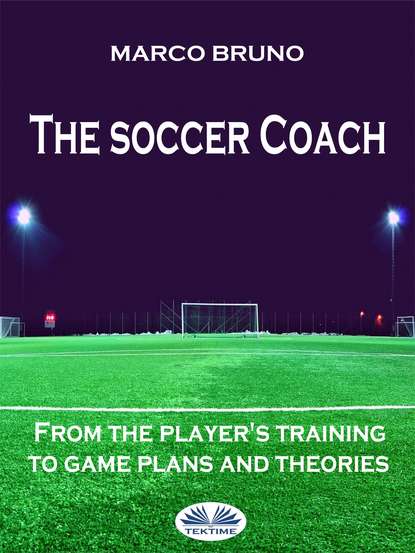По всем вопросам обращайтесь на: info@litportal.ru
(©) 2003-2024.
✖
The Soccer Coach
Настройки чтения
Размер шрифта
Высота строк
Поля
Maturation refers to the process of achieving the biological condition of adulthood and complete functionality; takes place in a long time, refers to:
- chronological age;
- skeletal age;
- state of sexual maturation. Physiological maturity in girls occurs 2-3 years earlier than boys.
Synthetically the indicators useful for determining the growth of the young are:
Growth Body size
Development Acquired skills
Maturation Biological conditions
Specialists in the growth and development sector have spent a lot of time studying the changes in stature and weight that accompany growth. Growth in height is very rapid in the first two years of life,
At 2 years the child reaches 50% of his height as an adult. The rate of growth is then much slower in childhood, but just before puberty the stature increases dramatically,
the peak of the growth rate occurs:
- about 11,4 years for girls;
- about 13,4 years for boys;
the achievement of the final height occurs:
- about 16-17 years for girls;
- about 18-20 years for boys;
The peak of body weight increase occurs:
- about 12.5 years for girls;
- about 14,5 years for boys;
Bones, joints, cartilages and ligaments form the support of the body structure; bones provide muscle insertion points, protect delicate tissues and represent calcium and phosphorus deposits. Between 14 and 22 years membranes and cartilages are transformed into bone. In an equally long time, between 13 and 20 years, the complete ossification of the different bones takes place. The prepubescent age is the most suitable for strengthening the bones in response to the stimulus of physical activity.
Muscle mass increases regularly from birth to adolescence following weight gain. The girls reach the maximum of muscle development between 16 and 20 years, boys between 18 and 25.
But we will talk about all these topics in a more specific way when we deal with the various motor skills.
For information, I report two graphs on the frequency of injuries to the back and knees in the young age caused by inadequate training. Age between 10 and 18 years
PHYSIOLOGICAL EFFECTS OF TRAINING
The physical condition
The human organism can increase its functional capacities to a considerable extent through the physiological process of training.
When our body is subjected to a physical exercise of certain intensity, reactions immediately occur:
- increase in heart beats;
- increase in respiratory rhythm;
- increase in depth of breaths;
- increase of secretion of sweat.
These reactions occur regardless of the physical condition of the subject even if the latter can determine the behavior and the entity. These are temporary changes because as soon as physical exercise ceases, these changes also regress and in a short time the body returns to its normal state. The time frame for returning to normal is usually shorter, the higher the condition of the individual.
The term “physical condition” indicates the particular state for which the athlete is in the best disposition, from a physical point of view, to perform a specific performance.
One of the typical manifestations of physical condition is the removal of the “fatigue threshold”.
What is fatigue? What is the fatigue threshold?
By fatigue we mean the diminution of the functional power of an organ, or of the whole organism, due to an excess of work.
The fatigue threshold represents the demarcation limit between complete efficiency and the beginning of the decline in functional power.
The training through multiple activities aims to achieve an improvement in performance and to remove the moment of the onset of fatigue.
In practice, training manifests itself as a systematic and rational repetition of certain movements and behaviors with the aim of obtaining a performance improvement.
The structural and functional changes that occur in our body because of training, have a close relationship with the type of motor performance that has caused them: every form of movement corresponds to a type of adaptation.
In practice it happens that in the phases immediately following the physical effort, the organic and muscular structures urged to produce and support it, are not limited to overcoming the fatigue situation with a return to normal conditions, but have a reconstructive reaction that leads them to overcome the situation before stimulation.
These moments of supercompensation have a limited duration and progressively returns to the normal situation.
It is necessary to provoke other situations of supercompensation before the previous ones are completely exhausted, that is to say a “summation of the training action”(Matwejew, 1972).
The repetition of these stressful situations will cause the gradual adjustment of athletic abilities, putting the body in a position to overcome workloads with less accumulation of fatigue, or to express higher and higher performances. Supercompensation should not be understood from a physiological point of view but only as an improvement in the accumulation of glycogen.
The larger the glucose stores (glycogen stores) in the soccer's muscle, later he will feel tired and the longer he will maintain the ability to do a very high intensity job
(Cogan Coyle, 1989).
The basic element of soccer performance in terms of energy use and consumption is the running action.
The specialists were concerned to detect “what” runs the amateur soccer player during a match; in general it has been verified that this run amounts to about 8,000 meters. This would not even represent a mid-level athletic performance, if referring exclusively to the total competition time (90’).
A careful analysis of the workload, shows that within this distance are carried out:
- sprints;





